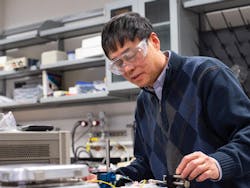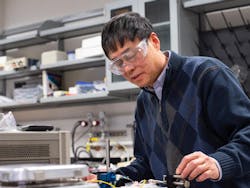A Flexible Polymer with Enhanced Electromechanical Coupling
Polymers are generally more lightweight and configurable than ceramics, making them a credible contender for exploring material improvements in imaging and robotics. Coupling the material with electromechanics, however, is not a simple task.
Qiming Zhang, distinguished professor of electrical engineering at Penn State, along with a team of interdisciplinary researchers, have developed a tetrapolymer with improved electromechanical coupling.
By adding two additional components to the base, poly (vinylidene difluoride) trifluoroethylene, piezoelectric effectiveness of the new polymer delivers 60% more efficient electricity generation than previous iterations, noted the researchers. The results of their new development were published in Science.
“Historically, the electromechanics coupling of polymers has been very low,” Zhang said. “We set out to improve this because the relative softness of polymers makes them excellent candidates for soft sensors and actuators in a variety of areas, including biosensing, sonar, artificial muscles and more.”
Doping the Polymers
A doping process was used to implement chemical impurities into the polymer. Doping is a method for increasing the conductivity of polymers by increasing the positive or negative charge on the polymer in order to modulate conductivity.
The paper explains how the doping process distorts the spacing between positive and negative charges within the polymer’s structural components. The distortion segregates the opposite charges, leading to the accumulation of an external electric charge on the component. This accumulation, noted Zhang, boosts electricity transfer in the polymer when it is deformed.
Taking it a step further, the doping effect was enhanced by “stretching” the polymer and, according to Zhang, the alignment created more of an electromechanical response relative to a polymer with randomly aligned chains.
What’s notable about Zhang’s research is that the efficiency of the polymer’s electricity generation was significantly increased. “With this process, we achieved a 70% efficiency—a vast improvement from 10% efficiency before.”
Ease of Fabrication
Robust electromechanic performance is commonly associated with stiff ceramic materials. But the enhanced coupling opens the possibilities for a variety of applications. For example, the new tetrapolymer displays resistance to sound waves similar to that of water and human tissues, which means it could be used in medical imaging, underwater hydrophones or pressure sensors.
Because polymers tend to be more lightweight and more pliable than ceramics, the potential for using the new material in distinct applications (such as imaging and robotics) is raised, as well as its potential to compete with traditional oxides.
About the Author

Rehana Begg
Editor-in-Chief, Machine Design
As Machine Design’s content lead, Rehana Begg is tasked with elevating the voice of the design and multi-disciplinary engineer in the face of digital transformation and engineering innovation. Begg has more than 24 years of editorial experience and has spent the past decade in the trenches of industrial manufacturing, focusing on new technologies, manufacturing innovation and business. Her B2B career has taken her from corporate boardrooms to plant floors and underground mining stopes, covering everything from automation & IIoT, robotics, mechanical design and additive manufacturing to plant operations, maintenance, reliability and continuous improvement. Begg holds an MBA, a Master of Journalism degree, and a BA (Hons.) in Political Science. She is committed to lifelong learning and feeds her passion for innovation in publishing, transparent science and clear communication by attending relevant conferences and seminars/workshops.
Follow Rehana Begg via the following social media handles:
X: @rehanabegg
LinkedIn: @rehanabegg and @MachineDesign

